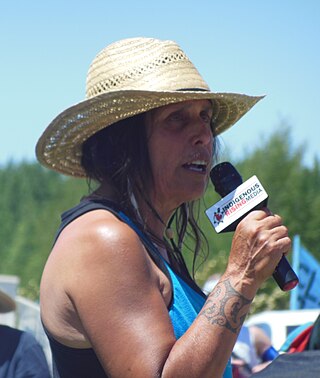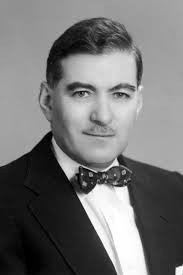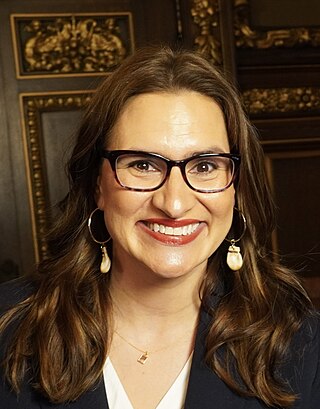Faith Smith | |
|---|---|
| Nationality | Lac Courtes Oreilles Ojibwe |
| Alma mater | Purdue University |
| Organization | NAES College |
| Title | President |
Faith Smith is a Native American activist and educator. Her career included work at Chicago's American Indian Center, with the Native American Committee, and most notably as the president of the Native American Educational Services College from 1974 to 2004. [1]
Smith spent her early childhood on the Lac Courte Oreilles Ojibwe reservation in Wisconsin. [2] She attended the Kinnamon School there. [3] Her family relocated to Chicago, [2] and she later attended and graduated from Purdue University in 1966. [4] She commented that "because of affirmative action, colleges were vacuuming Indian communities across the country, finding the brightest Indians, but after college, a lot of them couldn't make the transition back home. They had changed. Their communities had changed." [2]
In the mid-1960s, Smith became involved with the National Indian Youth Council, the first independent Native American student organization. After graduating from Purdue University, she began working at the Chicago American Indian Center (AIC) as a caseworker. [2] In a 1991 interview, Smith said that she and others at the AIC felt the organization should focus on the alleviation of "poverty and the problems of Indians on the streets," but that there was also "a strong contingent of people who felt that the center ought to be more of a middle-classy sort of thing, a social center or that sort of stuff." [4] In the late 1960s, Smith and others formed the Native American Committee (NAC) within the AIC to pursue more activist goals and a more comprehensive educational vision, the NAC incorporating as an independent body in 1970. [5] Member Helen Whitehead (Ho-Chunk-Ojibwe) described NAC: "Our main thrust is to start at the time they're very young and to build a positive self-image." [6]
Smith was an assistant to Robert Reitz, an anthropologist and long-time director of AIC, when Reitz died unexpectedly in 1971. Smith was appointed interim director. In August of that year, the AIC board of directors voted to dismiss Smith for "insubordination and questionable banking practices." Smith's supporters responded by convening a meeting of the full AIC membership, which both reinstated Smith and replaced numerous members of the board of the directors. [6]
That same year, NAC founded in collaboration with Chicago Public Schools the Little Big Horn School to address the needs of Native American high school students, and then in 1973 the O-Wai-Ya-Wa Elementary School program. In 1974, Smith and NAC founded and Smith became the president of the Native American Educational Services College (NAES College), the first urban institution of higher learning managed by and serving Native Americans. [1] [5] Smith served as president of the college until 2004, when she resigned and was replaced by Dorene Wiese. [7]

Winona LaDuke is an American economist, environmentalist, writer and industrial hemp grower, known for her work on tribal land claims and preservation, as well as sustainable development.
AIC may refer to:

The Ojibwe, Ojibwa, Chippewa, or Saulteaux are an Anishinaabe people in what is currently southern Canada, the northern Midwestern United States, and Northern Plains. They are Indigenous peoples of the Subarctic and Northeastern Woodlands.

Sol Tax was an American anthropologist. He is best known for creating action anthropology and his studies of the Meskwaki, or Fox, Indians, for "action-anthropological" research titled the Fox Project, and for founding the academic journal Current Anthropology. He received his doctorate from the University of Chicago in 1935 and, together with Fred Eggan, was a student of Alfred Radcliffe-Brown.

Bay Mills Community College (BMCC) is a public tribal land-grant community college in Brimley, Michigan. It is chartered by the federally recognized Bay Mills Indian Community of Michigan with a total enrollment of approximately 500 on-campus and online students. The students come primarily from Michigan's eastern Upper Peninsula and are 60% Native American. BMCC is a member of the American Indian Higher Education Consortium (AIHEC), a community of tribally and federally chartered institutions working to strengthen tribal nations, and a land-grant college.

The National Indian Youth Council (NIYC) is the second oldest American Indian organization in the United States with a membership of more than 15,000. It was the second independent native student organization, and one of the first native organizations to use direct action protests as a means to pursue its goals. During the 1960s, NIYC acted primarily as a civil rights organization. It was very active in the movement to preserve tribal fishing rights in the Northwest.
The American Indian Center (AIC) of Chicago is the oldest urban American Indian center in the United States. It provides social services, youth and senior programs, cultural learning, and meeting opportunities for Native American peoples. For many years, it was located Uptown and is now in the Albany Park, Chicago community area.

Susan Harnly Peterson was an American artist, ceramics teacher, author and professor.
Clara Sue Kidwell is a Native American academic scholar, historian, feminist and Native American author. She is enrolled in the Choctaw Nation of Oklahoma and of White Earth Ojibwe descent. She is considered to be a "major figure in the development of American Indian Studies programs."

Peggy Flanagan is an American politician, community organizer, and Native American activist serving as the 50th lieutenant governor of Minnesota since 2019. A member of the Minnesota Democratic–Farmer–Labor Party (DFL), Flanagan served in the Minnesota House of Representatives from 2015 to 2019.

Edith Emerald Johns also Edith Big Fire Johns (1915–1999) Winnebago-Nez Perce was an American nurse and community leader in the Chicago area in the mid-20th century. She was one of the founding staff of the Native American Educational Services College and was inducted into the Chicago Women's Hall of Fame and the Chicago Senior Citizens Hall of Fame.

The Chicago Blackhawks name and logo controversy refers to the controversy surrounding the name and logo of the Chicago Blackhawks, a National Hockey League (NHL) ice hockey team based in Chicago, Illinois. The use of terms and images referring to Native Americans/First Nations as the name or mascot for a sports team without permissions from or consultations with local Indigenous communities is a topic of public controversy in the United States and Canada. Since the 1960s, as part of the indigenous civil rights movements, there have been a number of protests and other actions by Native Americans and their supporters targeting the more prominent use of such names and images by professional franchises such as the Cleveland Guardians formerly known as the "Indians" of Major League Baseball (MLB) that was officially discontinued in 2016; the Washington Commanders formerly known as the "Redskins" of the National Football League (NFL), the NFL's Kansas City Chiefs and MLB's Atlanta Braves, the latter two attracting criticism of "the tomahawk chop" often performed by their fans. Like other teams with tribal mascots, there are calls from Indigenous activists and organizations to change the Blackhawks' name and logo and eliminate tribal mascots and imagery throughout sports. In contrast to generic names used by other teams, Blackhawks refers to a World War I-era U.S. Army division which was named for prominent Illinois-based Native American chief Black Hawk.
Terese Marie Mailhot is a First Nation Canadian writer, journalist, memoirist, and teacher.
Willard Earl LaMere was a Native American community organizer and educational leader in Chicago, Illinois in the mid twentieth century, a period when the US government's Indian termination policy encouraged Native Americans to assimilate into mainstream American society. Working to preserve Native American culture and values as Native Americans moved from reservations to cities, LaMere was instrumental in founding, among other organizations, the Native American Educational Services College, which became the first higher education institution in an urban setting managed by and serving Native Americans. He was also the college's first graduate.
Nancy Dumont (1936–2002) was a Native American educational leader who lived in and worked in Chicago, Illinois and Montana.
The Chicago Indian Village (CIV) was a short-lived American Indian affordable-housing protest group in and around Chicago, Illinois, in 1971–1972 that worked to raise awareness of and remedy poor living conditions for Native Americans in the Chicago area.
The Native American Committee (NAC) was an educational group in Chicago, Illinois, that created life-long learning programs and institutions for Native Americans. It was most notable for founding the Native American Educational Services College, the only institution of higher learning in an urban setting led by and serving Native Americans.

Robert V. Dumont Jr. (1940–1997) was a Native American educational leader who lived in and worked in Chicago, Illinois and at the Fort Peck Indian Reservation in Montana, most notably as one of the designers of the Native American Educational Services College and its initial director of academic programs.
Susan Kelly Power (1925–2022) was an American author and activist and member of the Yanktonai Dakota First Nation. She founded the American Indian Center of Chicago, which provided services for Native American peoples.
The Native American Educational Services College was an institution of higher education led by and serving Native Americans. It offered a BA in public policy within a curriculum that combined academic and tribal knowledge from 1974 to 2005. Its main campus was in Chicago, Illinois, but also grew to include satellite locations in Minneapolis, Minnesota, and on reservations in Montana, Wisconsin, and New Mexico.